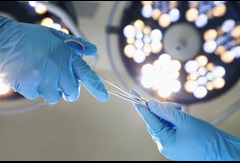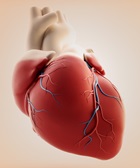Body Cooling Study
Emergency Preservation and Resuscitation for Cardiac Arrest from Trauma (EPR-CAT)
Principal Investigator: Samuel Tisherman, MD, professor of Surgery and director of the Division of Critical Care and Trauma Education at the University of Maryland School of Medicine
R Adams Cowley Shock Trauma Center
University of Maryland Medical Center
22 S. Greene St
Baltimore, MD 21201
Overview
 University of Maryland School of Medicine faculty researchers at the R Adams Cowley Shock Trauma Center are participating in a research study to test whether Emergency Preservation and Resuscitation (EPR) — a new medical procedure that cools the whole body— can improve outcomes for patients who suffer cardiac arrest due to massive blood loss. Any patient arriving at Shock Trauma who suffers a cardiac arrest after a penetrating trauma such as a gunshot or stab wound were eligible to be enrolled in the study. EPR may preserve the body's organs (specifically the brain and heart) during cardiac arrest and "buy time" for surgeons to find and repair injuries.
University of Maryland School of Medicine faculty researchers at the R Adams Cowley Shock Trauma Center are participating in a research study to test whether Emergency Preservation and Resuscitation (EPR) — a new medical procedure that cools the whole body— can improve outcomes for patients who suffer cardiac arrest due to massive blood loss. Any patient arriving at Shock Trauma who suffers a cardiac arrest after a penetrating trauma such as a gunshot or stab wound were eligible to be enrolled in the study. EPR may preserve the body's organs (specifically the brain and heart) during cardiac arrest and "buy time" for surgeons to find and repair injuries.
Background
Traumatic injuries, like those caused by car accidents or a shooting, are the leading cause of death in people under the age of 45. The main reason for death is losing too much blood. When the body loses a lot of blood there may not be enough blood left in the body for the heart to pump, which can cause the heart to stop beating (cardiac arrest).

Doctors usually do two things in this situation:
- Give patients large amounts of fluids into their veins.
- Open the left side of the patient's chest to perform open-chest heart massage and quickly repair any direct injuries in the chest.
Despite doctors trying everything above, few patients — less than 5 percent — survive this scenario. This is because the brain and other vital organs cannot survive more than a few minutes with no blood flow.
Study Procedures
EPR involves administering a large amount of cold fluid to cool patients to around 50°F. Doctors then try to find and stop the source of bleeding. A heart-lung bypass machine is used to restore blood flow to vital organs and warm the body back up.
Reason for Community Notification
In an emergency, it is often impossible to get a patient's or family member's consent or permission to participate. Federal guidelines allow some emergency research studies to be conducted without prior consent. However, researchers must inform the community about the study and seek the community's opinion. Once enrolled, patients can withdraw from the study at any time. Community members can also choose not to be enrolled in the study in advance by contacting the study researchers and getting an "opt-out" bracelet to wear.
Disclosure
 The principal investigator, Samuel Tisherman, MD, has a financial interest in intellectual property for the development of the EPR procedure and some of the associated hardware including special catheters and accessories which have been licensed to EPR Technologies. This means that it is possible that the results of this study could lead to personal profit for the individual investigator. This project has been carefully reviewed to ensure that patients' well-being holds more importance than any study results. Dr. Tisherman will not be involved in the recruitment of research participants, and will not administer the informed consent process.
The principal investigator, Samuel Tisherman, MD, has a financial interest in intellectual property for the development of the EPR procedure and some of the associated hardware including special catheters and accessories which have been licensed to EPR Technologies. This means that it is possible that the results of this study could lead to personal profit for the individual investigator. This project has been carefully reviewed to ensure that patients' well-being holds more importance than any study results. Dr. Tisherman will not be involved in the recruitment of research participants, and will not administer the informed consent process.
